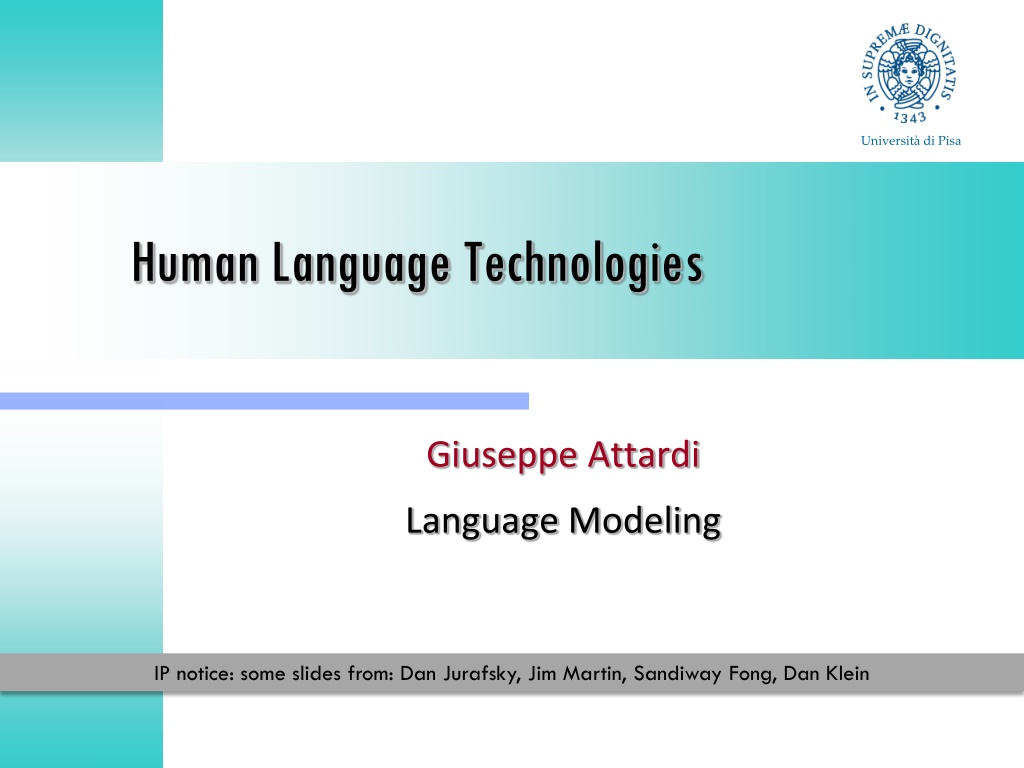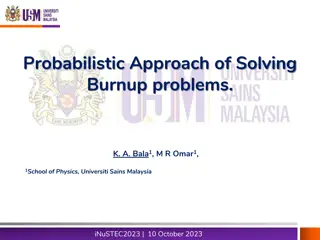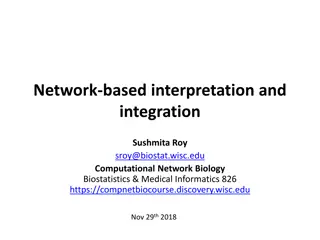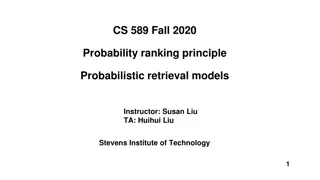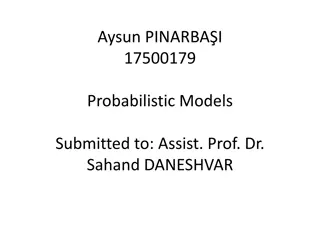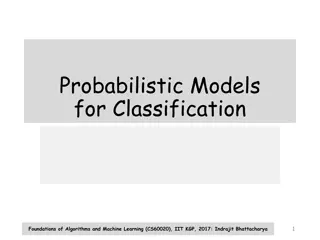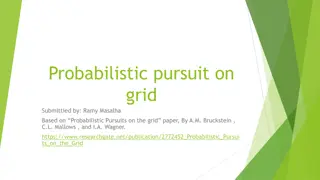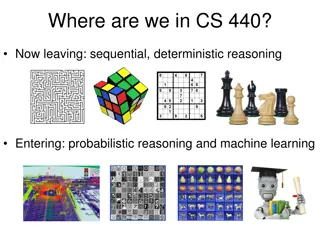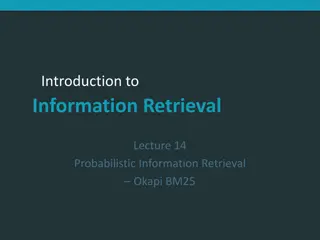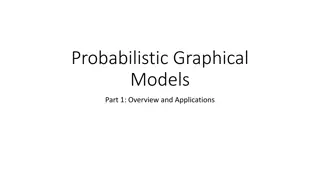Understanding Language Modeling: An Overview of Probabilistic Models and Applications
Dive into the world of language modeling with a focus on probabilistic models like N-grams, the Chain Rule, and Shannon Visualization Method. Explore the importance of assigning probabilities to textual data for tasks such as machine translation, spell correction, speech recognition, and more. Discover the significance of language models in improving English speech recognition systems.
Uploaded on Oct 03, 2024 | 0 Views
Download Presentation

Please find below an Image/Link to download the presentation.
The content on the website is provided AS IS for your information and personal use only. It may not be sold, licensed, or shared on other websites without obtaining consent from the author. Download presentation by click this link. If you encounter any issues during the download, it is possible that the publisher has removed the file from their server.
E N D
Presentation Transcript
Universit di Pisa Human Language Technologies Giuseppe Attardi Language Modeling IP notice: some slides from: Dan Jurafsky, Jim Martin, Sandiway Fong, Dan Klein
Outline Language Modeling (N-grams) N-gram Intro The Chain Rule The Shannon Visualization Method Evaluation: Perplexity Smoothing: Laplace (Add-1) Add-prior
Probabilistic Language Model Goal: assign a probability to a sentence Machine Translation: P(high winds tonite) > P(large winds tonite) Spell Correction The office is about fifteen minuets from my house" P(about fifteen minutes from) > P(about fifteen minuets from) Speech Recognition P(I saw a van) >> P(eyes awe of an) Summarization, question-answering, etc.
Why Language Models We have an English speech recognition system, which answer is better? Speech Interpretation speech recognition system speech cognition system speck podcast histamine Language models tell us the answer!
Language Modeling We want to compute P(w1,w2,w3,w4,w5 wn) = P(W) = the probability of a sequence Alternatively we want to compute P(w5|w1,w2,w3,w4) = the probability of a word given some previous words The model that computes P(W) or P(wn|w1,w2 wn-1) is called the language model. A better term for this would be The Grammar But Language model or LM is standard
Computing P(W) How to compute this joint probability: P( the , other , day , I , was , walking , along , and , saw , a , lizard ) Intuition: let s rely on the Chain Rule of Probability
The Chain Rule Recall the definition of conditional probabilities P(B| A)=P(A B) P(A) Rewriting: P(A B)=P(A)P(B|A) More generally P(A,B,C,D) = P(A)P(B|A)P(C|A,B)P(D|A,B,C) In general P(x1,x2,x3, xn) = P(x1)P(x2|x1)P(x3|x1,x2) P(xn|x1 xn-1)
The Chain Rule applied to joint probability of words in sentence P( the big red dog was ) = P(the) P(big|the) P(red|the big) P(dog|the big red) P(was|the big red dog)
Obvious estimate How to estimate? P(the | its water is so transparent that) P(the | its water is so transparent that) = C(its water is so transparent that the) ____________________________________________________________________________________________ C(its water is so transparent that)
Unfortunately There are a lot of possible sentences We will never be able to get enough data to compute the statistics for those long prefixes P(lizard|the,other,day,I,was,walking,along,and,saw,a) or P(the|its water is so transparent that)
Markov Assumption Make the simplifying assumption P(lizard|the,other,day,I,was,walking,along,and,saw,a) = P(lizard|a) or maybe P(lizard|the,other,day,I,was,walking,along,and,saw,a) = P(lizard|saw,a)
Markov Assumption So for each component in the product, replace with the approximation (assuming a prefix of N) n 1) P(wn |wn N+1 n 1 P(wn |w1 ) Bigram model P(wn|w1 n 1) P(wn|wn 1)
N-gram models We can extend to trigrams, 4-grams, 5-grams In general this is an insufficient model of language because language has long-distance dependencies: The computer which I had just put into the machine room on the fifth floor crashed. But we can often get away with N-gram models
Estimating bigram probabilities The Maximum Likelihood Estimate P(wi|wi 1) =count(wi 1,wi) count(wi 1) P(wi|wi 1) =c(wi 1,wi) c(wi 1)
An example <s> I am Sam </s> <s> Sam I am </s> <s> I do not like green eggs and ham </s> This is the Maximum Likelihood Estimate, because it is the one which maximizes P(Training set|Model)
Maximum Likelihood Estimates The Maximum Likelihood Estimate of some parameter of a model M from a training set T is the estimate that maximizes the likelihood of the training set T given the model M Suppose the word Chinese occurs 400 times in a corpus of a million words (e.g. the Brown corpus) What is the probability that a random word from some other text will be Chinese MLE estimate is 400/1000000 = .004 This may be a bad estimate for some other corpus But it is the estimate that makes it most likely that Chinese will occur 400 times in a million word corpus.
Maximum Likelihood We want to estimate the probability, p, that individuals are infected with a certain kind of parasite. The maximum likelihood method (discrete distribution): 1. Write down the probability of each observation by using the model parameters 2. Write down the probability of all the data Ind. Infected Probability of observation p 1 p p p 1 p 1 2 3 4 5 6 7 8 9 10 1 0 1 1 0 1 1 0 0 1 p p = 6 4 Pr( Data | ) 1 ( ) p p p 1 p 1 p 3. Find the value parameter(s) that maximize this probability p
Maximum likelihood We want to estimate the probability, p, that individuals are infected with a certain kind of parasite. Likelihood function: Ind. Infected Probability of observation p 1 p p p 1 p = = 6 4 ( ) Pr( Data | ) 1 ( ) L p p p p 1 2 3 4 5 6 7 8 9 10 1 0 1 1 0 1 1 0 0 1 - Find the value parameter(s) that maximize this probability 0.0012 0.0008 p L(p, K, N) p 0.0004 1 p 1 p 0.0000 p 0.0 0.2 0.4 0.6 0.8 1.0 p
Computing the MLE Set the derivative to 0: 0 =d dpp6(1- p)4= 6p5(1- p)4- p64(1- p)3= p5(1- p)3[6(1- p)-4p)= p5(1- p)3[6-10p] Solutions: p = 0 p = 1 p = 0.6 (minimum) (minimum) (maximum)
More examples: Berkeley Restaurant Project can you tell me about any good cantonese restaurants close by mid priced thai food is what i m looking for tell me about chez panisse can you give me a listing of the kinds of food that are available i m looking for a good place to eat breakfast when is caffe venezia open during the day
Raw bigram counts Out of 9222 sentences
Raw bigram probabilities Normalize by unigrams (divide by C(w-1)): Result:
Bigram estimates of sentence probabilities P(<s> I want english food </s>) = P(i|<s>) x P(want|I) x P(english|want) x P(food|english) x P(</s>|food) =.000031
What kinds of knowledge? P(english|want) = .0011 P(chinese|want) = .0065 P(to|want) = .66 P(eat | to) = .28 P(food | to) = 0 P(want | spend) = 0 P(i | <s>) = .25
Practical Issues Compute in log space Avoid underflow Adding is faster than multiplying log(p1 p2 p3 p4) = log(p1) + log(p2) + log(p3) + log(p4)
Shannons Game What if we turn these models around and use them to generate random sentences that are like the sentences from which the model was derived. Jim Martin
The Shannon Visualization Method Generate random sentences: Choose a random bigram <s>, w according to its probability Now choose a random bigram (w, x) according to its probability And so on until we choose </s> Then string the words together <s> I I want want to to eat eat Chinese Chinese food food </s>
Shakespeare as corpus N=884,647 tokens, V=29,066 Shakespeare produced 300,000 bigram types out of V2= 844 million possible bigrams: so, 99.96% of the possible bigrams were never seen (have zero entries in the table) Quadrigrams: What's coming out looks like Shakespeare because it is Shakespeare
Lesson 1: the perils of overfitting N-grams only work well for word prediction if the test corpus looks like the training corpus In real life, it often doesn t We need to train robust models, adapt to test set, etc.
Train and Test Corpora A language model must be trained on a large corpus of text to estimate good parameter values. Model can be evaluated based on its ability to predict a high probability for a disjoint (held-out) test corpus (testing on the training corpus would give an optimistically biased estimate). Ideally, the training (and test) corpus should be representative of the actual application data. May need to adapt a general model to a small amount of new (in-domain) data by adding highly weighted small corpus to original training data.
Smoothing Since there are a combinatorial number of possible word sequences, many rare (but not impossible) combinations never occur in training, so MLE incorrectly assigns zero to many parameters (aka sparse data). If a new combination occurs during testing, it is given a probability of zero and the entire sequence gets a probability of zero (i.e. infinite perplexity). In practice, parameters are smoothed (aka regularized) to reassign some probability mass to unseen events. Adding probability mass to unseen events requires removing it from seen ones (discounting) in order to maintain a joint distribution that sums to 1.
Smoothing is like Robin Hood: Steal from the rich and give to the poor (in probability mass) Slide from Dan Klein
Laplace smoothing Also called add-one smoothing Just add one to all the counts! Very simple MLE estimate: Laplace estimate: Reconstructed counts:
Laplace smoothed bigram counts Berkeley Restaurant Corpus
Note big change to counts C(want to)went from 608 to 238! P(to|want) from .66 to .26! Discount d = c*/c d for chinese food = .10 So in general, Laplace is a blunt instrument A 10x reduction! But Laplace smoothing not used for N-grams, as we have much better methods Despite its flaws Laplace (add-k) is however still used to smooth other probabilistic models in NLP, especially For pilot studies in domains where the number of zeros isn t so huge.
Add-k Add a small fraction instead of 1 k = 0.01
Even better: Bayesian unigram prior smoothing for bigrams Maximum Likelihood Estimation P(w2|w1) =C(w1,w2) C(w1) Laplace Smoothing PLaplace(w2|w1) =C(w1,w2)+1 C(w1)+vocab Bayesian Prior Smoothing PPrior(w2|w1) =C(w1,w2)+ P(w2) C(w1)+1
Lesson 2: zeros or not? Zipf s Law: A small number of events occur with high frequency A large number of events occur with low frequency You can quickly collect statistics on the high frequency events You might have to wait an arbitrarily long time to get valid statistics on low frequency events Result: Our estimates are sparse! no counts at all for the vast bulk of things we want to estimate! Some of the zeroes in the table are really zeros But others are simply low frequency events you haven't seen yet. After all, ANYTHING CAN HAPPEN! How to address? Answer: Estimate the likelihood of unseen N-grams! Slide from B. Dorr and J. Hirschberg
Zipf's law decompressor are needed to see this picture. f 1/r (f proportional to 1/r) there is a constant k such that f r = k
Zipf law: interpretation Principle of least effort: both the speaker and the hearer in communication try to minimize effort: Speakers tend to use a small vocabulary of common (shorter) words Hearers prefer a large vocabulary of rarer less ambiguous words Zipf's law is the result of this compromise Other laws Number of meanings m of a word obeys the law: m 1/ f Inverse relationship between frequency and length
Practical Issues We do everything in log space Avoid underflow (also adding is faster than multiplying)
Language Modeling Toolkits SRILM http://www.speech.sri.com/projects/srilm/ IRSTLM Ken LM
Google Book N-grams http://ngrams.googlelabs.com/
